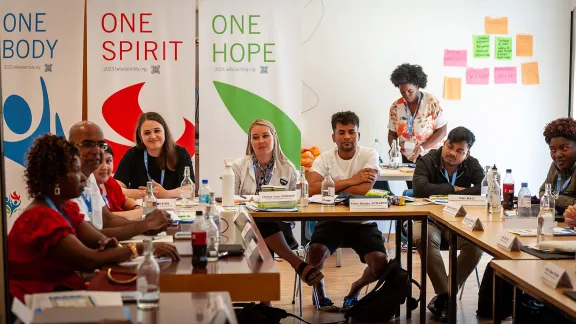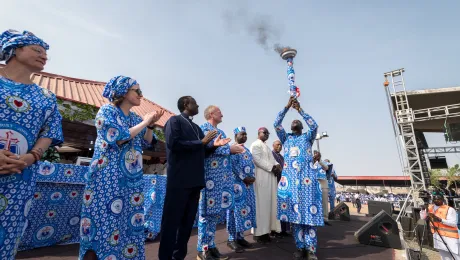
Rama Ramanathan, second from left, shares ideas with participants at the LWF Lay Leaders’ Seminar in Geneva. Photo: LWF/S. Gallay
A participant in LWF’s 6th international seminar for lay leaders reflects on his experience and lessons learned
“Church” conjures a building. A congregation. National institutions. Source of legitimation. Or irritation.
“LWF” conjures images of books and pamphlets. Of refugees. Of clergy, men and women in gowns and clerical collars, in Geneva.
LWF is a communion or federation of churches. What does “churches” mean and what is the role of lay people in those churches?
I became a Christian in 1980. I’ve been in churches in three countries, in four denominations. What I know about churches comes from classes, sermons, leadership teams, tasks, publications.
Until I attended the LWF International Seminar for Lay Persons in Church Leadership positions, I only knew vaguely how to answer the question “Is there a “Lutheran way” of being or doing church?”
What did LWF teach us over four days in Geneva and three days in Wittenberg?
The Lutheran way
After Jesus’ resurrection, at Pentecost, God called people to be saved, to become disciples of Jesus. They assembled. They practiced baptism. They sang together. They broke bread together.
Their assemblies came to be called churches. Initially, they were led by apostles. Later, by elders and bishops.
Church members were “witnesses of Christ’s resurrection.” They proclaimed the Good News of salvation. They served their neighbours. Their service, when organized, became known as diakonia.
Christians, now “church members,” proclaim the Gospel, through their words and by living as persons embraced by God.
A Lutheran “essential” is that works are a fruit, a byproduct of justification (by grace), not a means of being accepted by God.
Though birthed by the Spirit, the church is not free of strife. Church work requires leadership. Christian leaders must aim to be, like God, inclusive, dialogical, and consistent. Missing this aim is often the cause of conflicts, which may remain unresolved for long periods.
A Lutheran “essential” is the limited power of clergy: they are constrained by synods, sometimes dominated by lay members.
Diversity of callings
As the centuries passed, churches grew. So did conflicts within and between churches, and with the state.
In response, leaders of Lutheran churches – first called “evangelical” churches – gathered, prayed, discussed, and discerned the tenets of truth and unity.
The result was an array of core documents. Collected in 1580 in “the Book of Concord,” these include the historic Creeds, the Small and Large Catechisms, Smalcald Articles, the Augsburg Confession and Apology, Treatise on the Power and Primacy of the Pope, and the Formula of Concord.
A striking feature of the Book of Concord is that a layman, Philip Melanchthon, wrote the Articles, Apology and Treatise.
I was also struck by the bold announcement of the role of laypersons in the altarpiece of St Mary’s Lutheran Church, Wittenberg, Luther’s “home church,” which shows Melanchthon baptizing a child. It includes a host of other laypersons, including the wives of Martin Luther and Lukas Cranach. Laypersons dominate it.
The altarpiece is a painting by Lukas Cranach, Sr. He was Luther’s “media man” for establishing the evangelical churches. He too was a layman!
Another artwork central to the seminar was The Trinity, a 1411 CE painting by Andrei Rublev which depicts the dynamic unity of the Three Persons of the Trinity.
In Wittenberg, this icon was on the altar table of the chapel in which we gathered daily to pray. It’s a powerful symbol of God’s invitation and acceptance.
What does being and doing church “the Lutheran way” mean? It means embracing diversity, as God does. It means accepting that God calls some to be clergy, some to be laity, but they are not divided by a hard line. It means pursuing together, locally and globally, the mission of transforming the world.


